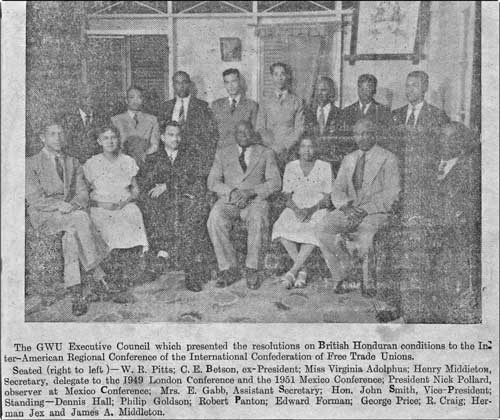Trade Unions: The Formation of the BHGWU
Employment and Wages have always been a critical issue in our Labour History. I recall reading an article in Narciso Valdes’s newspaper, the “O-Yeah” which appeared in 1933. The unknown writer expressed concern about the stability of the British Pound, Shillings and Pence and the rising cost of living in the British Colony. By 1935, Antonio Soberanis, a barber was leading a demonstration against Belize Estate & Produce Company, Ltd., mahogany and chicle exporters. His ‘Unemployed Workers Association’ was probably the first group to consider organizing into Labour groups or a union. Indeed, there was great labour agitation among hundreds of workers in the Colony. Ironically, Robert Sydney Turton was already involved in the slashing of Sapodilla trees for the extraction of chicle gum and was fast becoming a wealthy man with the support of Wrigley’s of the U.S.A. The clash of Turton with Belize Estate & Produce Co. Ltd over the December 31st, 1949 Devaluation of the Belize Dollar would set the stage for a bitter struggle between these two financial giants. Labour events following the devaluation would show in the Colony’s history how wealthy men and foreign interests moved to manipulate young, intelligent graduates of the Jesuits’ Education Institution, St. John’s College.”
In 1936, Roberto Sydney Turton, who was described as multi-millionaire and Belize Estate’s rival, won a seat in the Legislative Council. Belize Estate was then a subsidiary of the giant, multi-national corporation, J. Glicksten Property and Investment Trust Ltd., which had become a part of a new United Kingdom based conglomerate, the International Timber Corporation. My Dad would later visit one of their huge mahogany plants in Glasgow, England when he attended the Belize constitutional talks in London in August, 1960. At that time Belize Estate owned more than one million acres of the Colony, British Honduras, now Belize. No doubt, British investors were backing their people in the Colony while the Americans who had vested interests in Chicle were supporting Turton. By 1943, news paper writer and publisher Valdes discontinued the “O-Yeah” and began the publication of “The Belize Billboard”. The stage was being set but the ‘players’ were needed.
– Extracted from the unpublished manuscript of “The Jaws of Politics” by Nicholas Pollard, Jr.
No doubt it can be clearly understood that the very metamorphosis of the Trade Union Movement was manipulated by politicians who were controlled by either Belize Estate to a certain degree or by Robert Sydney Turton in a more militant way. Following the birth of Soberanis ‘Unemployed Workers Association’ one William Campbell formed a new union called ‘The Belize Painters, Carpenters and Cabinet Makers Union’ sometime around 1942. It was quite likely that the union was registered under the British new Trade Union Ordinance of 1941. However, little is known of that union.
In 1943, shipwrights Berton Locke and Clifford Betson (or Betzen) formed the British Honduras General Workers Union which was registered under the 1941 Trade Union Ordinance. By 1949, the BHGWU had over 4,000 registered workers in the essential services area of Gallon Jug, the Public Works, the Stevedores of the Water Front Workers under Belize Estate Shipping and United Fruit Company, Belize Estate Timber Yard on the Northern Highway and Hoods Bakery. Indeed, the BHGWU had grown into a powerful union. By 1948, Christian Social Action Movement activist, Nicholas Anthony Ignatius Pollard, Sr. had formed his first union at his work place, James Brodie & Company, Limited. His union was called the Mercantile Union.
Following the Devaluation of the Belize Dollar in 1949, Robert Sydney Turton, who was the financial victim of the devaluation, quickly moved to organize a militant group to fight the British investors. This group of players were the Christian Social Action Movement, a Jesuit trained movement under the influence of the Papal Encyclical document called the Rerum Novarum. Under the disguised leadership of Turton’s secretary George Price, the CSAM dissolved itself and formed the Peoples Committee on January 1st, 1950. On April 23rd, 1950, it contested the elections at the Annual General Meeting of the BHGWU and took over the union’s executive with Pollard as President and John Smith as vice- president. Here was planted the seeds of the Nationalist Movement that would proved to be a serious adversary to the British Investors.
Whether the former President, Clifford Betson was indeed in agreement with the takeover, the late Dr. Cedric Grant in his book, “The Making of a Modern Belize”, wrote: “The new executive, confident and condescending, was benign enough to agree to a resolution of the General Secretary, Henry Middleton, the long-standing colleague of the defeated presidential candidate that ‘in recognition of his seven years as ‘pioneer of the union’ Betson be elected ‘Past President’ with the right to sit on the new GWU Executive Council. As if to remind Betson that his era of trade unionism was over, the Executive Council conferred upon him the doubtful honorific title of ‘Patriarch of the Union’ and voted a suitable purse for his ‘distinguished service to the cause of labour.’”
By late 1951, General Secretary Henry Middleton also resigned from the GWU and moved himself into the shadows of the colony. Dr. Grant also wrote: “The political leaders had assumed control of the GWU not only for its organizational value in the districts but perhaps more important because they believed that industrial objectives could be more effectively pursued by political means. As the union gained strength (some 8,000 members) it was increasingly dominated by politicians. These leaders extended their personal patronage upon those of the individual politicians. Indeed this dependency, which the politicians seldom admitted, was the dominant feature of the trade union movement in the 1950s.”
